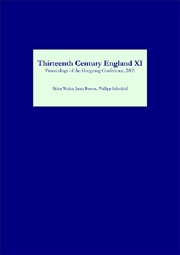Book contents
- Frontmatter
- Contents
- LIST OF ILLUSTRATIONS
- PREFACE
- CONTRIBUTORS
- ABBREVIATIONS
- ‘Adam of Bristol’ and Tales of Ritual Crucifixion in Medieval England
- Ethics and Office in England in the Thirteenth Century
- Some Aspects of the Royal Itinerary in the Twelfth Century
- The minority governments of Henry III, Henry (VII) and Louis IX compared
- Scottish Queenship in the Thirteenth Century
- Ethnicity, personal names, and the nature of Scottish Europeanization
- Power, Preaching and the Crusades in Pura Wallia c.1180–c.1280
- A Forgotten War: England and Navarre, 1243·4
- The Appointment of Cardinal-deacon Otto as Legate in Britain (1237)
- Matthew Paris and John Mansel
- The Burial of Noblewomen in Thirteenth-Century Shropshire
- Dynastic Conflict in thirteenth-century Laxton
- Absenteeism: The Chronology of a Concept
Scottish Queenship in the Thirteenth Century
Published online by Cambridge University Press: 12 September 2012
- Frontmatter
- Contents
- LIST OF ILLUSTRATIONS
- PREFACE
- CONTRIBUTORS
- ABBREVIATIONS
- ‘Adam of Bristol’ and Tales of Ritual Crucifixion in Medieval England
- Ethics and Office in England in the Thirteenth Century
- Some Aspects of the Royal Itinerary in the Twelfth Century
- The minority governments of Henry III, Henry (VII) and Louis IX compared
- Scottish Queenship in the Thirteenth Century
- Ethnicity, personal names, and the nature of Scottish Europeanization
- Power, Preaching and the Crusades in Pura Wallia c.1180–c.1280
- A Forgotten War: England and Navarre, 1243·4
- The Appointment of Cardinal-deacon Otto as Legate in Britain (1237)
- Matthew Paris and John Mansel
- The Burial of Noblewomen in Thirteenth-Century Shropshire
- Dynastic Conflict in thirteenth-century Laxton
- Absenteeism: The Chronology of a Concept
Summary
Medieval queenship as an area for study has enjoyed dynamic growth in the last generation. The pioneering work of Pauline Stafford and Jinty Nelson on early medieval queens has shown the tremendous value of looking at queens and queenship through the lens of gender, emphasising the effects of the female lifecycle on the status and opportunities of the queen, and the ways in which the existing structures of queenship constrained the activities of individual kings' wives. John Parsons has applied a similar approach to post-Conquest queens in England, paying special attention to the queen's place in the kinship network and the means through which royal women might achieve and express some form of self-realisation and through that, group identity. The work of Margaret Howell has taken a slightly different approach, certainly not neglecting gender, but stressing the need to use theoretical frameworks flexibly and pay due attention to the particular. Their work, and the work of many other scholars in the same field, has made the history of queens and queenship on either side of the Norman Conquest a lively and fruitful area of debate.
Such scholarship has shown the thirteenth century to be a time of exciting developments in western European queenship. Henry III's marriage to Eleanor of Provence in January 1236 brought a new queen consort to court after a gap of two decades. Howell's work on Eleanor, who was queen consort for over thirty years, reveals how she skilfully played the various roles of wife, mother, counsellor, regent, patron, leader of faction, and later, queen mother.
- Type
- Chapter
- Information
- Thirteenth Century England XIProceedings of the Gregynog Conference, 2005, pp. 61 - 81Publisher: Boydell & BrewerPrint publication year: 2007



